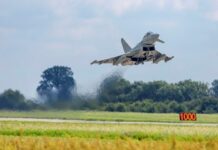The UK’s decision to add an air-based capability as a second national nuclear system is sending a clear deterrent message to any prospective nuclear-armed adversary, according to the Royal Air Force’s (RAF’s) Chief of the Air Staff (CAS).
Speaking at the DSEI 2025 conference in London on 11 September, Air Chief Marshal Harv Smyth said, “The RAF will soon have the opportunity to offer NATO additional robust, credible and capable response options because we’ve added this important rung to our escalation ladder.
“I would expect potential adversaries to take key note of this change,” he added.
In June 2025 – in its Strategic Defence Review (SDR) and in statements at NATO’s Hague Summit – the UK announced plans to procure 12 Lockheed Martin F-35A Lightning II aircraft, which are certified to carry nuclear weapons, and for the UK to participate in NATO’s dual-capable aircraft (DCA) shared nuclear mission. Under the DCA activity, around half-a-dozen NATO states operate aircraft than can carry US B61 air-dropped tactical nuclear weapons. The F-35As will carry the B61-12: the latest operational variant.
The UK has identified a requirement to provide an air-delivered, non-strategic weapon system that can generate deterrence at a lower level on the nuclear escalation ladder than the high-end strategic deterrent provided by the UK’s submarine-based, nuclear-armed ballistic missile system. This requirement emanated from NATO concerns about potential Russian tactical nuclear weapons use on the Ukrainian battlefield.
Reflecting the SDR’s commitment to a ‘NATO first’ posture to underpin UK defence and security, ACM Smyth noted that “A nuclear-capable Lightning presents the UK with a mechanism to provide considerable support to our ‘NATO first’ approach and NATO’s overall nuclear mission.”
He added that the UK’s new deterrent capability will provide robust, graduated response options that will, for NATO and its members, reflect the dynamic strategic environment they face and, for the UK in particular, fill a deterrent gap between its conventional capabilities and submarine-based nuclear system.
Recognising the nuclear risks evident in both the Ukraine War and the wider Euro-Atlantic instability that has surrounded the conflict, the CAS noted the need to move quickly to ready the RAF to operate this capability. “This will be a core effort during my tenure as CAS, spurred on by the fact that multiple NATO [countries] with a fielded DCA capability have already offered the most intimate of support to deliver this capability at pace and with precision,” said ACM Smyth. “This is a superb example of the power of trusting partnerships,” he added.
For the UK itself, the chief pointed to the need for the RAF to build its ‘nuclear IQ’ quickly. “There are multiple challenges to address in delivering this capability, not least the fact that there are very few individuals serving in the [RAF] today who have experience of the nuclear enterprise,” he said.







![Stratus symbol Initially deployed during Operation Granby, the United Kingdom’s contribution to Operation Desert Storm in 1991, the RAF’s air-launched anti-radiation missile proved to be a radar killer. The missile remained in service, and in the RAF’s inventories, until 2013. [Thomas Withington]](https://euro-sd.com/wp-content/uploads/2025/11/ALARM-Thomas-Withington-Kopie-218x150.jpg)






